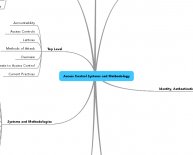
Vehicle Access Control Systems
 Access control for vehicles is as old as RFID based access control in general. The introduction of magnetic stripe swipe cards, and later contactless RFID badges in the early eighties have initiated the birth of the current access control industry. Ever since those early days manufacturers, integrators and clients have also pondered over the best way to control vehicle access to estates, sites and parking area’s. The predominant technology used for vehicle access in the last decade is without doubt microwave technology: 2, 45 GHz readers identify cars and other vehicles that are equipped with semi-active or active badges. Supporting reading distances of over 10 meters, this technology provides for a convenient and resilient way of vehicular access control.
Access control for vehicles is as old as RFID based access control in general. The introduction of magnetic stripe swipe cards, and later contactless RFID badges in the early eighties have initiated the birth of the current access control industry. Ever since those early days manufacturers, integrators and clients have also pondered over the best way to control vehicle access to estates, sites and parking area’s. The predominant technology used for vehicle access in the last decade is without doubt microwave technology: 2, 45 GHz readers identify cars and other vehicles that are equipped with semi-active or active badges. Supporting reading distances of over 10 meters, this technology provides for a convenient and resilient way of vehicular access control.
But after a decade without groundbreaking innovation it seems that change is upon us. New technology is knocking at our door, challenging us to rethink our solutions for convenient and secure vehicle identification. But before we further explore the future, it might be wise to first look at today’s realm.
Current practice
Currently, when a security manager or facility manager is thinking about controlling access to his estate for vehicles, he or she will basically have to choose between conventional prox technology or the microwave alternative. Manufacturers of prox cards and readers, especially those operating in the 120-125 kHz frequency, have found ways to extend the reading distance of the card technology they deploy. Through enhancement of the reader or the tags used, a reading distance of around 1 meter has been reached, thus providing a fairly convenient way for drivers to present badges at the outer perimeter. The good thing about this solution is that the same prox cards are used to provide people with access to the building, thus limiting the extra investment needed for vehicular access control when an access control system already is in place. Only one card type needs to be distributed and administered.
But utilising prox technology also has a few downsides namely convenience. How many of us have had moments when we are hanging out of our car window struggling to properly position an access control badge so that an impressive looking card reader can arrogantly decide that we have gone through enough hardship to allow or deny us access?
Another downside is that in this scenario we are not really identifying vehicles, we are only identifying one person sitting in that particular vehicle. Clients looking for convenient vehicular access control therefore very often prefer the use of the earlier mentioned microwave readers that are supplied by a handful of specialised manufacturers. Semi actives tags that are positioned behind the windscreen or at other locations at the vehicle are read by readers without the need for physical strain on the driver. Tags that are physically and logically linked to the vehicle enable for a very convenient and secure way to access the secured site.
Figure 1: convient reading distance
Now let’s have a look at some of the current trends and developments that are finally reshaping the vehicle identification industry and that provide security managers with more choice and more tools to establish a safe and secure environment for their employers.
Knowing who is at the gate
The story of the Trojan Horse holds a relevant message even today. For real security and peace of mind, you must not only identify an approaching vehicle, but also the driver inside. Identifying only the vehicle rather than the driver could encourage theft of a vehicle to access your facilities, making the vehicle a “Trojan Horse” by giving automated access to what is perceived as an authorized vehicle.
The ever increasing need for a simple way to track the driver credential and potentially the vehicle identification as a lock & key combination, has paved the way for a new philosophy which dictates that a vehicle can never be left with an active AVI access credential present unless occupied by an authorized driver.
A Driver Based AVI tag is made up two components: an in-vehicle card reader/transmitter and a personnel credential, such as contactless building access card. The in-vehicle reader will read the building access card and “Boost” the signal to an external reader at ranges up to 33 feet (11 Meters), which will allow plenty of time for the back end security controller to activate the barrier or gate opening prior to the time the vehicle arrives. The Booster device will in effect act as the lock and the building access card as the key. In some cases the Booster will contain its own embedded Vehicle ID, which allows the back end the ability to immediately match the right driver with the right vehicle.

















